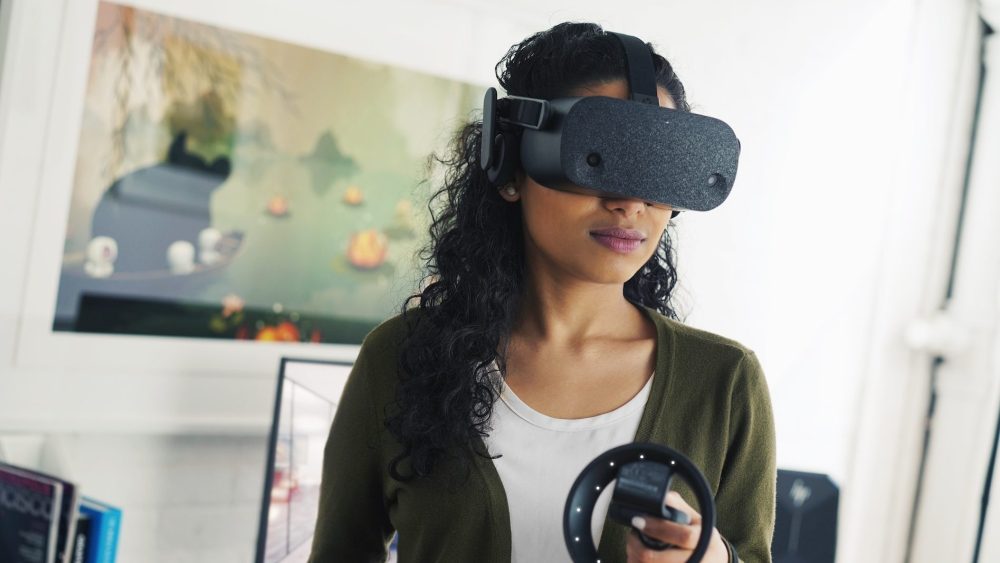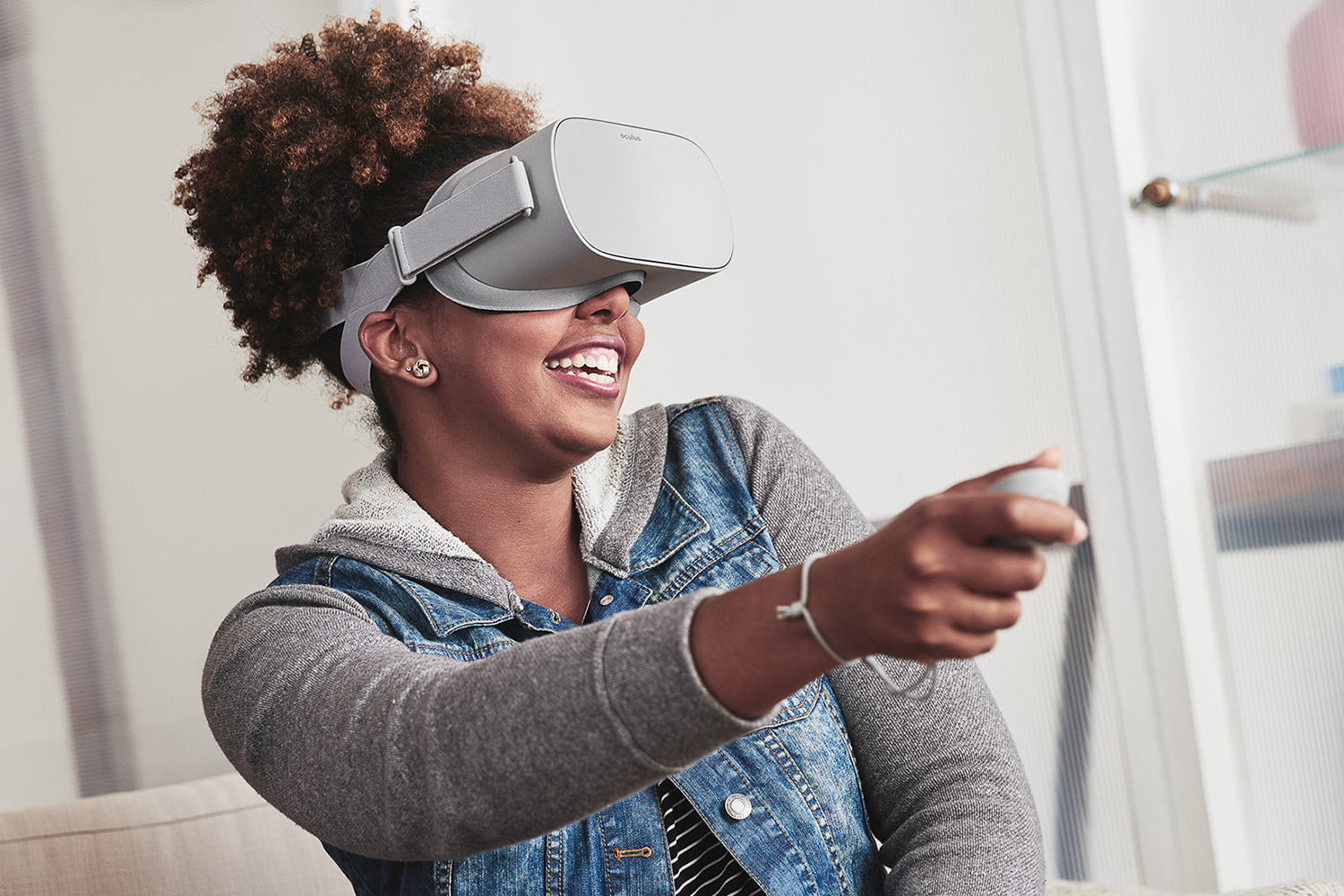From Tron to
Ready Player One, passing through Nirvana and Henry, cinema has often imagined futuristic scenarios in which a virtual reality viewer is an integral part of society. Today, we are at a turning point, with the market full of interesting products, also of an economic level. Of course, to obtain a truly immersive effect, a
high-level VR viewer is still required and, in this case, the cost still remains prohibitive. But in any case, the path to virtual reality is open and in fervent evolution. We must, however, make a distinction between
virtual and augmented. The first form of reality is the one we will cover in our guide and is totally digitally constructed.
A VR 3D viewer, in fact, will allow us to immerse ourselves in a completely alternative world, whose images are sent to our eye through special integrated screens.
Augmented reality, on the other hand, is a mix between what we see with the naked eye and images simulated by the viewer. The result, therefore, is a hybrid between real and digital that expands our possibilities to the nth degree. With a few rare exceptions,
VR and AR viewers use different technologies. And here we will focus only on the former.
How does a VR headset work?
The task of a virtual reality viewer is to recreate in the eyes and mind of the wearer the clear sensation of being elsewhere. To achieve this,
the quality of the screens is fundamental, starting from the resolution which must be very high. Basically, once the VR headset is worn, the images come to our eyes filtered by two very powerful lenses that expand the depth, adding the third dimension. Furthermore, thanks to a viewing angle similar to the human one, the visual field is extremely realistic. When it comes to movement, however, specific sensors come into play (
gyroscope, accelerometer, magnetometer) that simulate movement in space. The most advanced models also add to these technologies laser cameras capable of mapping the 3D VR viewer from the outside, so as to ensure even better precision in movement. Finally, thanks to the controller and other optional accessories, we will be able to interact with the digital reality itself. Coming to the fields of use, VR products do not find their natural use only in games and when viewing videos at 360 degrees. But
they are also exalted in didactic simulations, in virtual tours for cultural purposes and in scientific projects, in particular in the medical and engineering fields.
The display first of all
The screen is the main element of the entire VR viewer because it is the link between the source of the image and the eye. In the case of
smartphone displays, the mobile phone will be positioned in the special internal compartment, becoming the display itself. In other cases, the connection to a PC or a console will allow the passage of the images. The dimensions can vary from 5 to 7 inches and, in the case of mobile devices, it will be important to evaluate their compatibility with the phone itself. And now let's see which elements of the screen we will have to carefully evaluate when purchasing:
Construction technology and resolution
To begin with, it must be said that there are commercially available 3D VR viewers with one or two screens. As a rule, the latter are more performing although much depends on the technology with which they are built. Currently, the top-of-the-range models are equipped with
OLED or Super AMOLED screens, characterized by bright colors and absolute blacks. But there is no lack of devices with a classic LCD display. In terms of resolution, we can say that the higher it is, the better the performance will be. This is because the lenses greatly amplify the image and, consequently, the pixels are more easily visible to the naked eye if they are not in sufficient number. In addition, low resolution vision can cause symptoms such as nausea and disorientation, called motion sickness. In any case, a resolution of
1200x1080 pixels per eye is more than enough to offer a satisfying experience. The same applies if we are using a smartphone that should have at least 2K resolution.
Refresh rate
Refresh rate indicates the number of times the image is redrawn on the display every second.
The higher this value, the greater the sensation of fluidity and naturalness given by the viewer for virtual reality. The refresh rate is expressed in hertz (Hz) and a value of 60, excellent for a TV or a PC monitor, becomes almost insufficient for the VR world. Not surprisingly, the most technologically advanced models boast a
refresh rate of 90 Hz.
Viewing angle
The visual field of the human eye can be expressed through an angle that indicates the
visible lateral space by fixing a point in front of us. Fundamental to enhance the effect of identification and immersion, the viewing angle of the best viewers settles between 100 and 110 degrees and is equal to that of our eyes.
The cheaper models, on the other hand, will rely on smaller angles, between 80 and 100 degrees, with a consequent drop in overall performance.
The importance of sensors: comparison of types of viewer
When it comes to VR, the depth of the experience is linked to a double send to the presence or absence of some sensors on the viewer.
Accelerometer, gyroscope, magnetometer and proximity sensor are essential and are the architects of what is defined in as
"Head tracking". Some models, then, are also equipped with
"Eye tracking", or sensors that track the movement of the eye. Finally, it is thanks to the motion sensors that Motion tracking takes place, present only in the top of the range viewers. Let's see how these technologies work together:
Head tracking
Head tracking is the starting point for any VR viewer because it creates a correspondence between real movements and movements in virtual reality. By moving our heads, we will have to feel that the digital environment around us is moving around us in a realistic way. Only in this way, we will get a good immersive effect. At the base of the Head tracking, we find the
classic sensors also present in smartphones and, for this reason, many of the models in circulation are designed to work in conjunction with the mobile phone. Let's think, for example, of the super-cheap
Google Cardboard, a cardboard viewer that can be purchased for a few rupees and which acts exclusively as a support for the phone.
Eye tracking
Even the movement of the eyes represents a very important element and a viewer for
quality virtual reality must be able to trace it correctly. By doing so, in fact, it will be possible to make the depth of field and the proportions of the objects credible. In addition, the most advanced Eye tracking allows you to create
blurred images alongside those in focus, in order to simulate reality with even greater detail.
Motion tracking
Last but not least,
tracking body movements is the definitive feature for a complete 3D VR experience. But let's talk about complex technologies, included only in high-end models. These are products dedicated to use on
consoles or PCs and, in the second case, to give our best, even our computer will have to enjoy
excellent computing power. At the base of the operation of these sensors we find a video camera to be positioned in front of the user, capable of tracking their position and movements through the emitted lasers. In this way, the movements within virtual reality will appear completely natural and, consequently, more involving. Then there are
models equipped with two cameras, capable of further expanding the space for our movements in the virtual environment.
Connectivity
Although the market of VR 3D viewers is aiming decisively towards
totally wireless models, it is not currently possible to fully enjoy this universe without the use of cables. This is because the passage of data between VR viewer and PC (or console) is so massive that it still requires physical connections. It is true that some entirely wireless devices already exist on the market. We speak, however, of less powerful and immersive viewers, to be used mainly with the smartphone. Here is an excursus on the two types of connectivity:
Cable connectivity
Among the most appreciated and performing viewers we find, without a doubt, the
Oculus Rift and the
HTC Vive. Both are equipped with refined sensors for motion tracking and high resolution OLED displays. They work strictly in combination with a
computer, processing and expanding the image that comes to them from the source. In addition to the fact that the
PC must be very powerful, a fundamental element is that the flow of data is carried by an
HDMI cable and a
USB cable that work together, the first to carry the audio and video part, the second to provide the power supply. . In concrete terms, alongside or on the back of the virtual reality viewer, we will see two cables emerge and, although their location is properly studied, they could be a hindrance for some movement. Finally, do not overlook the need for another USB port on the computer to which to connect the
laser camera for Motion tracking.
Wireless connectivity
We have seen how cable connectivity is decisive for giving the user fluid, realistic and high resolution images. But even high-end devices provide the ability to connect gadgets and accessories through
Bluetooth. We think, for example, of the game controller, pointers with movement support or, perhaps, a pair of wireless headphones. In addition, some cheaper devices can be called wireless in full. Let's think, for example, of the VR models that work with the smartphone, such as the
Samsung Gear VR. But not only that, there are models called
stand-alone that do not even need the phone to work.
Oculus Go is the most interesting example. We are talking about a mid-range viewer on which it is possible to
download apps and view streaming content through a Wi-Fi connection. Light and totally cable-free, it offers a good experience with games and videos but without reaching the levels of the best models. On the other hand, working wirelessly,
it requires frequent recharging and the built-in battery guarantees a not really exciting autonomy.
Controller and other accessories
The controller is an essential component that allows us to interact with the VR dimension in which we are moving. It will allow us to move, point the indicator towards some objects to move or modify them and navigate the menu of our VR viewer. The basic controller can be of two types: a
joypad or a
pointer to be held in the hand, capable of detecting the movement of our arm and replicating it in virtual reality. The more complex systems, to ensure superior realism, provide
a second pointer in the kit. Both, however, are wireless, an aspect that offers the user greater freedom of movement. Some VR 3D viewers, then, are equipped with a
remote control that allows us to manage everything as if it were the menu of a computer or home TV. Light, solid and often equipped with touch controls, controllers can take the strangest forms. In some cases, moreover, everything moves are
gloves capable of perfectly reproducing hand gestures. Or,
dedicated gaming controllers that aim to create a particularly profound simulation effect. Think, for example, of
racing wheels or
shotgun pointers for shooters.
The added value of sound
Video game enthusiasts know the
value of sound well within the gaming experience. We are talking about a decisive element, to say the least, because it makes the action extremely enthralling. Furthermore, thanks to
surround headphones, it is possible to enjoy highly realistic ambient sound, which will offer us the possibility of placing sounds in the surrounding space. Needless to say, the same thing applies to a virtual reality viewer with the appropriate VR games. Indeed, here the acoustic element becomes even more significant. The sound, whether it comes from the
smartphone or from the computer, acquires a huge amplitude and multiplies the impact of the experience. For this reason,
some VR viewers (including the
Oculus Rift) are equipped with integrated adjustable headphones. The models of VR 3D viewers without headphones, however, allow the user to connect their own through a
classic jack or Bluetooth. In the first case, the sound performance will be higher but the presence of the cable could hinder the movements. In the second case, in the face of lower quality audio, we will enjoy greater freedom.
Weight, dimensions and design
The VR viewer to function at its best must rest on the head and nose and adhere perfectly to the face on the front. Wearing such a helmet can imply
neck fatigue due to excessive weight. Precisely for this reason, manufacturers are constantly making lighter and more ergonomic products. The cheapest 3D VR models usually have low weight. The
Google Cardboard range is unbeatable in this sense, made up of cardboard displays weighing a few grams. There is to consider, however, the presence of the smartphone inside which represents an important variable and, if too heavy, can make the viewer for virtual reality unbalanced forward. The most advanced products
weigh from 300 to 600 grams and vary in size depending on the presence or absence of a head strap and headphones. Generally speaking, we can say that no product is excessively bulky. Coming to design, the discussion becomes very interesting. Speaking of futuristic products,
the lines and shapes also tend towards a very cinematographic imagination. If the colors remain between gray and black, there is no lack of relief designs and LEDs. Among the most particular, we find the
Playstation VR, Sony device consisting of a sort of crown that surrounds the head and supports the viewer.
Building materials and comfort
Long sessions immersed in a VR environment can make you feel your weight if our device is not comfortable enough. In fact, if the
construction materials are not of quality and the settings of the VR viewer are not adequate, there is a risk of compromising the overall experience. For this, the best models are equipped with straps and supports useful to find the perfect position for the viewer, avoiding that it is too heavy for the head and nose. In certain cases, there is only one band behind the nape while other solutions provide for the use of
a third support to be tightened above the skull. In this perspective, soft and hypoallergenic materials are preferable, especially as regards the inside of the virtual reality viewer, the portion that rests directly on the forehead and surrounds the eyes.
Rubber, silicone, breathable and sweat-proof fabrics: these are the main materials used. But also structurally, it is important that our 3D VR viewer is solid and light. Hence the use of special plastics designed just for this.
Online platforms for apps and games
A VR viewer without an ecosystem of content to be used becomes practically useless. Precisely for this reason, in a phase in which these devices are also spreading among the non-specialized public,
it is essential that there is no lack of apps, games and videos to try. And so, the
Android and iOS online stores are gradually filling up with apps dedicated to VR 3D viewers. And the most popular streaming services, including
Netflix and YouTube, are designing specific content for virtual reality. In addition to 360-degree videos, we also find many revisited VR apps online including, for example,
Google Street View. All downloadable on the smartphone and usable with the viewer in a few moments. In the case of models for PC and console, however, the download is performed externally and, as a rule, these are much more substantial files. In particular, among the many contents to be tested, we find many
free games. As regards the viewers to be associated with a computer, Steam VR remains one of the reference platforms. As for consoles, however,
Playstation VR holds the record. But there are many other stores to draw on, some of which are designed exclusively for a certain type of product. This is the case, for example, of
Samsung VR for the viewers of the South Korean house.














